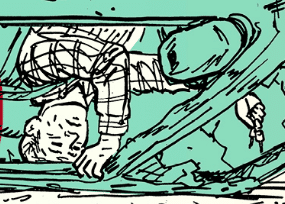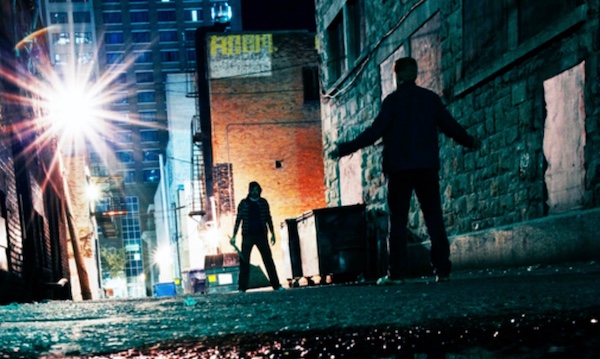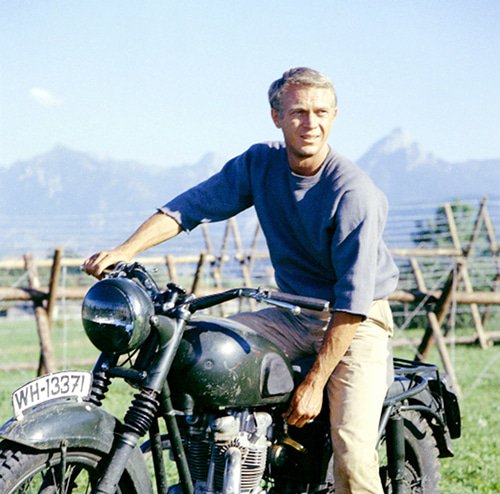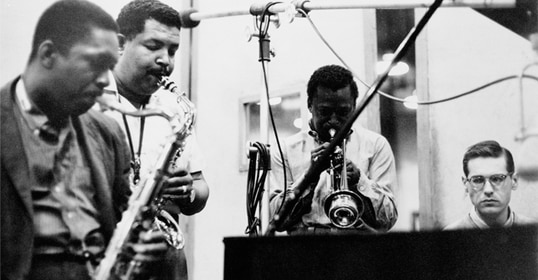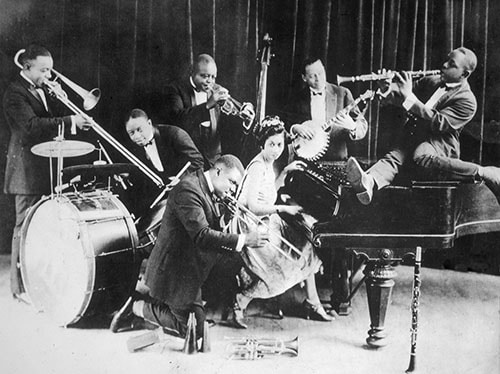
Jazz.
It’s the music that many men say they like, but don’t actually know anything about.
Which is a shame for a whole host of reasons.
For starters, jazz has had a major influence on most popular music genres in the 20th century — rock, hip-hop, Latin…the list goes on and on. Having an understanding of jazz will give a music connoisseur a deeper appreciation of whatever their favorite genre happens to be.
Second, jazz music perfectly encapsulates the American ideal of collaboration mixed with individuality, and its history is really the history of the country. Born from the music of African-American slaves, it intertwines with so many different facets of modern American life – movies, dance, art, literature, and of course, race. Thus, an understanding of jazz will provide the student of history a fascinating window into 20th century America.
Third, I think it goes unnoticed by lots of folks, but there’s definitely a masculine ethos that underlies jazz. Its emphasis on the solo and improvisation requires a performer to embrace risk, and adds an element of palatable bravado to the music. What’s more, while jazz is certainly collaborative, it’s imbued with a competitive spirit as well. Jazz musicians of the past often tried to one-up each other in virtuosity and in moving the music in brand new directions. Piano players in 1920’s New York would often muster for rousing back-and-forth “battles,” each man trotting out his best stuff during late night cutting sessions. These kinds of competitions in musical mastery continue today, even taking the popular form of the piano bar that has become so trendy in the last few years.
Finally, jazz music is simply good music. There’s a genre of jazz for every man out there. At least, I think so.
If you’ve ever wanted to get into jazz, and don’t know where to start, below we’ve laid out a beginner’s introduction to the different genres of jazz, along with a few artists and songs for each that serve as good starting places for the neophyte to dip his toes.
Hopefully this post will serve as a springboard for getting deeper into this uniquely American music, so that the next time someone asks if you like jazz, you can do more than nod!
The Blues (late 19th century-present)
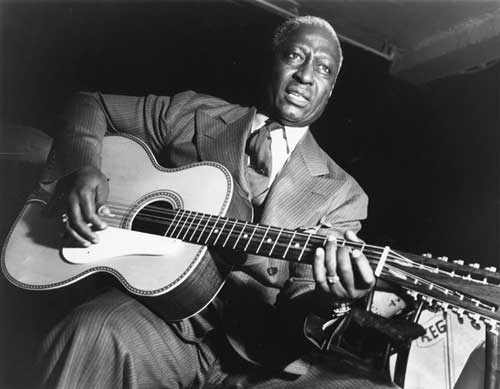
Lead Belly
Like jazz, the blues also traces its roots to 19th century Southern plantations where slaves and later, sharecroppers, would sing work songs while they toiled under the hot sun. As African-Americans learned to play European instruments, the guitar became a popular accompaniment to the soulful singing and led to the development of the blues style. The blues is characterized by a specific chord progression — often the twelve bar blues progression — as well as blue notes. A blue note is a note sung or played at a slightly lowered pitch than the major scale, which gives the note that distinctly bluesy, sad sound.
While blues developed side-by-side with jazz in the late 19th and early 20th centuries, jazz artists would incorporate many bluesy elements into jazz — particularly the twelve bar blues progression. It’s been said that when jazz gets too abstract, it always returns to the blues.
Artists You Ought to Know
W.C. Handy. Considered the Father of Blues; driving force behind the mainstreaming of blues.
Huddie “Lead Belly” Leadbetter. Wrote dozens of blues songs that have been covered countless times. Legend has it he was shot in the belly with a shotgun and survived, hence the nickname “Lead Belly.”
Bessie Smith. This singer’s style would leave a profound impact on later jazz vocalists.
Songs to Check Out
Ragtime (1895—1918)
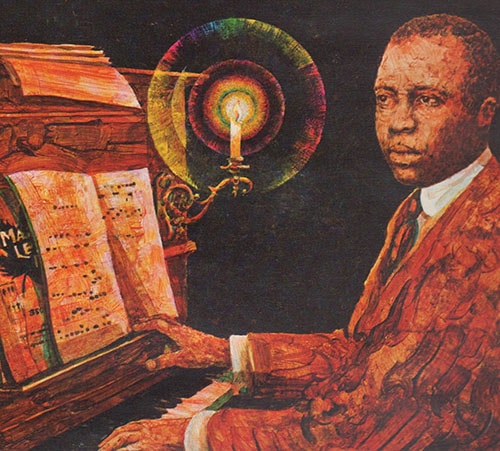
Scott Joplin
Along with the blues, ragtime was an important pre-cursor to jazz. While it could be played with other instruments, ragtime is primarily music for the piano. The defining feature of ragtime is a syncopated rhythm — accenting the notes that aren’t usually accented which gives the music an offbeat feel. The techniques used by ragtime pianists would influence later jazz pianists.
Artist You Ought to Know
Scott Joplin. “The King of Ragtime.” Composed two of the most famous pieces of ragtime music (see below).
Songs to Check Out
New Orleans Jazz (1900-1920)
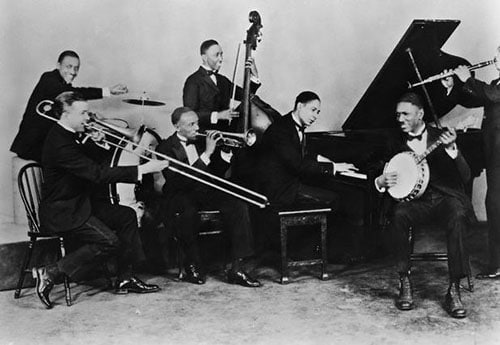
Jelly Roll Morton’s Red Hot Peppers
New Orleans Jazz originated with the black brass marching bands of New Orleans. Consequently, instruments like the cornet (very similar to trumpet) would become a staple in jazz. As ragtime swept the nation, these New Orleans brass bands began composing and playing more syncopated pieces. In addition to ragtime, band musicians blended in the bent notes and cords of the blues.
The invention of the Big Four beat by musician Buddy Bolden gave room for artists to improvise, and made the jazz we know today possible.
New Orleans jazz bands were typically small and consisted of a “frontline” of a cornet/trumpet, clarinet, and trombone, and then a “rhythm section” that had at least two of the following: banjo, string bass, drums, and piano. This group of instruments was the primary vehicle in New Orleans Jazz. Improvisation was collective and would be heard when a lead instrument would engage in a spontaneous counterpoint to another instrument. The jazz soloist had yet to take center stage.
The spread of New Orleans Jazz across America was quick thanks to the invention of the phonograph player. Many New Orleans Jazz musicians left New Orleans and set up shop in Chicago and New York during the Great Migration.
Artists You Ought to Know
Buddy Bolden. Sometimes called the Father of Jazz; discovered or invented the Big Four beat that made jazz possible.
Joe “King” Oliver. Cornet player and bandleader; pioneered the use of mutes (placing something like a hat over the end of the trumpet to muffle the sound a bit); mentor and teacher of Louis Armstrong.
Jelly Roll Morton. Began as a ragtime composer; the first jazz composer; loosened up the syncopated rhythm of ragtime so there was more of a “swing” in the music.
The Original Dixieland Jass Band. They weren’t actually the original — they called themselves the originals for marketing; band consisted of all white members; made the first jazz recording ever; helped popularize jazz music among white Americans.
Songs to Check Out
- “Dipper Mouth Blues” by Joe “King” Oliver featuring Louis Armstrong
- “King Porter Stomp” by Jelly Roll Morton
- “Wolverine Blues” by Jelly Roll Morton
Chicago (1920s)

Louis Armstrong
Jazz bands in Chicago differentiated themselves from New Orleans bands in several ways, such as replacing the banjo with a guitar, adding a saxophone to the horn section, and changing from a 4/4 beat to a 2/4. But the most important change to come out of Chicago was the ascendency of the individual solo.
And the man who pioneered and mastered the jazz solo was Satchmo himself: Louis Armstrong.
Artist You Ought to Know
Louis Armstrong. Trumpet player; pioneered the jazz solo; had talent for melodic improvisation and an unmistakable voice. While Armstrong is closely associated with New Orleans Jazz, it was in Chicago that he made a name for himself.
Albums to Check Out
- The Hot 5s – Armstrong’s first album with the band he led under his own name. Check out “Two Deuces.”
- The Hot 7s – Armstrong’s second recording with a band led under his own name.
New York (1920s)
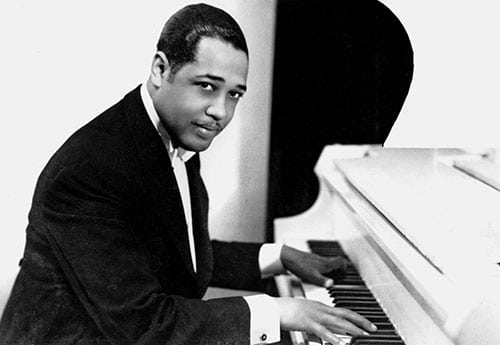
Duke Ellington
From Chicago, jazz traveled to New York where even more innovations occurred, the most important being the development of stride piano, a style which would play a prominent role in jazz from then on out. Larger bands began forming in New York City, which paved the way for the Big Band Era of the 1930s.
Artists You Ought to Know
James P. Johnson. Considered the father of stride piano. Wrote “The Charleston.”
Duke Ellington. Moved from Washington D.C. to NYC in the 1920s. Considered one of the greatest jazz composers ever and many of his songs have become American standards. Ellington and his orchestra was the house band at the famous Cotton Club in 1927.
Songs To Check Out
- “The Charleston” by James P. Johnson (stride piano example)
- “Carolina Shout” by James P. Johnson (stride piano example)
- “Flaming Youth” by Duke Ellington (this is the song we use as the introduction of the AoM podcast)
Swing and the Big Band Era (1930-1945)
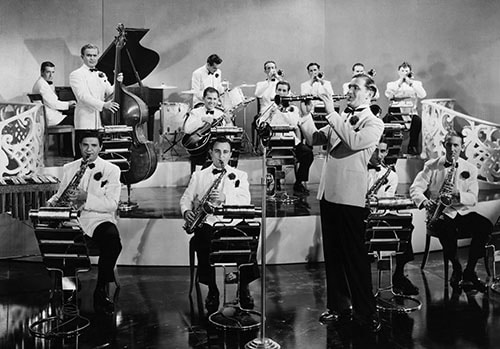
Benny Goodman and His Orchestra
Up until the 1930s, jazz music was enjoyed primarily by a specific sub-culture of the US population. Its associations with the seedy side of life as well as African-American culture made it unpalatable to much of mainstream white America. That changed with the rise of the Big Band Era in the 1930s. Because the Great Depression put so many regional jazz bands out of work, jazz musicians were plentiful and cheap during the 30s. Consequently, a few prominent jazz bandleaders were able to build large orchestras.
Instead of the more syncopated, “hot” style of earlier jazz, Big Bands played a looser, flowing style called swing. Swing music is primarily dance music and several new styles of dance were inspired by swing music including the Lindy Hop and the jitterbug. In addition to jazz, Big Bands also played American standards, often giving them a jazzier feel in the process.
After WWII when the economy picked up, putting together a large orchestra became much more expensive and Big Band and swing music died out.
Artists You Ought to Know
Fletcher Henderson. Credited with establishing the formula of swing music; formed one of the first Big Bands; considered (along with Duke Ellington) one of the greatest jazz arrangers ever.
Benny Goodman. Called the “King of Swing”; one of the greatest jazz clarinet players ever; first jazz musician to play Carnegie Hall; because he was white, Goodman helped popularize jazz music with white Americans; one of the first bandleaders to lead an integrated orchestra.
Count Basie. Piano player and bandleader; had a much more sparse playing style than Ellington.
Duke Ellington. Duke Ellington continued to be an influential voice all throughout the Big Band Era.
Cab Calloway. Bandleader and singer; prognosticator of jive talk and “hi di hi di hos”; wearer of zoot suits; Cab Calloway and his orchestra was one of the most popular big bands during the swing era.
Songs to Check Out
- “It Don’t Mean a Thing” by Duke Ellington
- “Sing Sing Sing” performed by Benny Goodman
- “Minnie the Moocher” by Cab Calloway (also check out “Reefer Man” if only for the laughs)
Jazz After the Big Band Era
Since its beginning, jazz has always been a music catered to a popular audience. It was music to dance to or at least tap your feet to. But around the late 1940s, a shift began among jazz musicians. Instead of writing music for a popular audience, they began writing music for themselves. As Grammy nominated jazz musician Marc Cary told me, “Jazz started to get heady after the Big Band Era.”
Jazz became more and more abstract. While jazz has always been improvisational, musicians had always improvised within a set of constraints. After the Big Band Era, musicians began pushing the boundaries of what constituted jazz or even music. This desire for complete liberation from traditional musical confines was simply a reflection of changing attitudes and ideas in post-war America. Experimentation increased dramatically within jazz during the post-war years and the speed at which new styles developed increased as well.
With the above in mind, as we explore jazz from 1950 and on, note that it becomes increasingly difficult to categorize artists and even particular songs. Many jazz musicians straddled several different styles of jazz all at once and mixing genres was common.
Bebop (1939-1950)
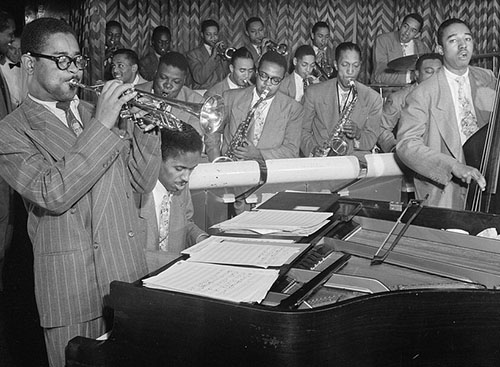
Dizzy Gillespie
The origins of bebop go back to the 1940s when young musicians playing in more traditional Big Bands would get together after shows for all-night jam sessions in which experimentation was encouraged. According to jazz historian Ted Gioia, bebop was a rebellion against “the populist trappings of swing music.” Bebop artists eschewed simple riffs for more asymmetrical ones. Solo improvisation took a more prominent role, and the tempo picked up. When you listen to bebop it sounds sort of frantic and racing. It’s nothing like the bouncy and danceable big band tunes of the prior decade.
Artists You Ought to Know
Coleman Hawkins. Tenor saxophonist; laid the foundation for the bebop era in a 1939 recording of “Body and Soul”; led a combo that included Thelonious Monk, Miles Davis, Max Roach; recorded the first bebop session in 1944.
Charlie Parker. Nicknamed “Bird”; saxophonist; he, along with trumpeter Dizzy Gillespie, became leading figures in the bebop era.
Dizzy Gillespie. Trumpet virtuoso; his puffy cheeks, bent horn, and scat singing became his trademark; infused Afro-Latin music into jazz.
Thelonious Monk. Piano player and considered one of the great jazz composers; his style was very indicative of bebop — angular and abrupt; composed several songs that are now jazz standards (“Round Midnight” and “Straight, No Chaser”).
Bud Powell. Piano virtuoso — sometimes called the “Charlie Parker of Piano”; he, along with Charlie Parker and Dizzy Gillespie, are credited with the development and maturation of bebop.
Max Roach. Drummer who helped develop the bebop style of drumming. Played with Coleman Hawkins, Dizzy Gillespie, Charlie Parker, and others.
Songs to Check Out
- “Blue Monk” by Thelonious Monk
- “Round Midnight” by Thelonious Monk
- “Night in Tunisia” by Dizzy Gillespie
- “Shaw ‘Nuff” by Dizzy Gillespie and Charlie Parker
Cool (1949-1955)

Miles Davis
Cool jazz was a direct response to bebop. While bebop was fast, frantic, and frenzied, cool was relaxed. Musicians downplayed the rhythm and focused on the melody and experimented by incorporating classical music elements like the whole tone scale. Cool bands would also include classical instruments in their line-up. Cool jazz is sometimes referred to as “West Coast Jazz,” though jazz aficionados would argue there’s a difference between the two.
Artists You Ought to Know
Miles Davis. Trumpet; one of the most influential musicians of the 20th century; not only lead the development of cool, but also played an integral role in the development of hard bop, modal, free, and fusion jazz. His album Birth of the Cool defines cool jazz.
Dave Brubeck. Piano player and leader of the Dave Brubeck Quintet; considered one of the great jazz pianists.
Gerry Mulligan. Saxophonist (though he played other instruments, too); played the saxophone with Miles Davis in Birth of the Cool; collaborated with Chet Baker.
Chet Baker. Trumpet player in Gerry Mulligan’s band. Became one of the defining figures of cool jazz.
Songs & Albums to Check Out
- “Take Five” performed by Dave Brubeck
- “Bernie’s Tune” by the Gerry Mulligan Quartet featuring Chet Baker
- Birth of the Cool by Miles Davis
Hard Bop (1951-1958)
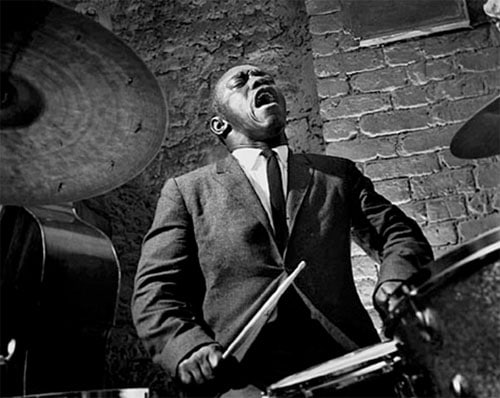
Art Blakey
Many jazz musicians felt that cool was too classical and European. Hard bop was a return to jazz that was more blues-based and Afro-centric. Hard bop musicians incorporated influences from gospel and rhythm and blues music into jazz.
Artists You Ought to Know
Miles Davis Quintet. Several influential jazz musicians played in this band during the hard bop era.
Art Blakey. Drummer who helped develop hard bop drumming; his style is still influential today.
John Coltrane. Saxophonist; member of the Miles Davis Quintet.
Sonny Rollins. Tenor saxophonist.
Horace Silver. Pianist who helped develop hard bop.
Songs to Check Out
- “Moanin’” by Art Blakey
- “Nica’s Dream” by Horace Silver
- “St. Thomas” by Sonny Rollins
- “Giant Steps” by John Coltrane
Modal (Late 1950s)

Miles Davis, Kind of Blue
Bebop and cool compositions were usually based on predetermined chord progressions. In contrast, modal jazz tunes, were based on a predetermined mode, or a certain musical scale. Also, unlike bebop or cool where changes and shifts happened quickly, in modal, the changes in modes happened very slowly. Because modal musicians only had to think about how to mix up the seven notes in a mode, they could focus more on creative improvisations.
Artists You Ought to Know
Miles Davis
John Coltrane
Songs & Albums to Check Out
- Kind of Blue by Miles Davis
- “Impression” by John Coltrane
Free Jazz (1959-1970)
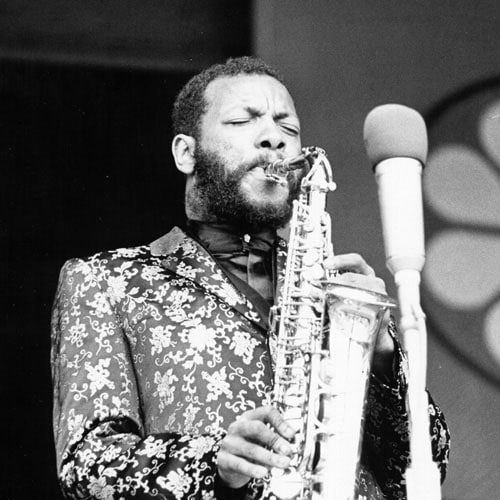
Ornette Coleman
As we’ve seen, ever since the Big Band Era, jazz musicians pushed against musical constraints. Free jazz was pretty much the elimination of any and all limitations. Instead of compositions being based on a series of predetermined chords or even modes, free jazz was simply based on sounds. Musicians would often make squeaks and squawks by over-blowing their horns. Extreme improvisations and creativity were encouraged.
In addition to eliminating predetermined chords, free jazz musicians often eliminated predetermined meters. Free jazz returned to the collective improvisation of New Orleans Jazz — the different members were constantly reacting to each other. Old became new. Free jazz captures the loosening norms in American society during the 1960s.
Artists You Ought to Know
Ornette Coleman. Played several instruments, but most known for his work on the saxophone. Often considered the father of free jazz.
Cecil Taylor. Pianist known for his highly energetic and complex improvised sounds; his piano playing style is very much percussion-like.
Charles Mingus. Bassist; defies categorization, though is often associated with the free jazz movement because he favored collective avant-garde, New Orleans-style improvisation.
John Coltrane. Coltrane’s later recordings are vey much influenced by free jazz.
Songs to Check Out
- “Lonely Woman” by Ornette Coleman (Coeman’s album The Shape of Jazz to Come is a great example of the beginnings of free jazz)
- “Enter Evening” by Cecil Taylor
Fusion (1969-1990)
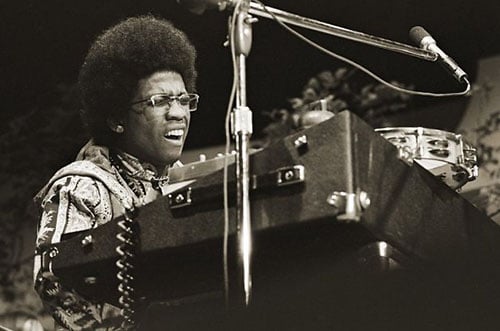
Herbie Hancock
After nearly three decades of exploring the boundaries of the avant-garde, jazz musicians in the 1970s began to bring back jazz to the mainstream with jazz fusion. Or how Cary put it, “Fusion was jazz’s last ditch effort to make jazz popular again.”
Jazz fusion is the fusion of jazz with different popular genres of music, particularly rock and funk. Jazz fusion combined the power, rhythm, and simplicity of rock ‘n roll with the sophisticated improvisation of jazz. Electronic amplification as well as other electronic musical devices from rock and funk gave jazz a different sound. While some critics and traditional jazz musicians don’t think jazz fusion is actually jazz, this style did introduce jazz to an entirely new audience.
Artists You Ought to Know
Miles Davis. What genre of jazz did Davis not help shape?
Weather Report. One of the earliest and most influential jazz fusion groups.
Herbie Hancock. Piano player who played in the Miles Davis Quintet; pioneered electronic instruments in jazz; his type of fusion typically combines funk with jazz; one of the most influential living jazz musicians today.
Chick Corea. Keyboarder; pioneered electric jazz; brings Latin jazz elements into his jazz fusion.
Freddie Hubbard. Trumpet player; fused funk with jazz.
Songs & Albums to Check Out
- Bitches Brew by Miles Davis
- “Birdland” by Weather Report
- “Chamelon” by Herbie Hancock
- “Mr. Clean” by Freddie Hubbard
Conclusion
I hope you enjoyed this introduction to jazz and I hope this has inspired you to dig deeper into the genre.
I want to thank pianist and composer Marc Cary for his help on this post. His insights into jazz in the post-Big Band Era were extremely helpful. Check out his latest album Amazon.com I also want to thank friend, colleague, and jazz manager Charles Brack for his suggestions on artists I should include. Thanks to him, “Mr. Clean” is now a regular in my iTunes lineup.
If you’d like to delve deeper into the history of jazz, I highly recommend two books that I used in the research of this post:
The History of Jazz by Ted Gioia
Notes and Tones by Arthur Taylor
Other resources:



